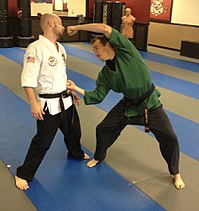Kenpō
This article needs additional citations for verification. (February 2010) |
 American Kenpo | |
| Also known as | Kempo, Kenpo |
|---|---|
| Focus | Hybrid |
| Country of origin | |
| Creator | Unknown |
| Kenpō | |||||||||||||
|---|---|---|---|---|---|---|---|---|---|---|---|---|---|
| Chinese name | |||||||||||||
| Chinese | 拳法 | ||||||||||||
| |||||||||||||
| Japanese name | |||||||||||||
| Kanji | 拳法 | ||||||||||||
| Hiragana | けんぽう | ||||||||||||
| |||||||||||||
Kenpō (Japanese: 拳法,けんぽう) is the name of several martial arts. This term is often informally transliterated as "kempo", as a result of applying Traditional Hepburn romanization,[1] but failing to use a macron to indicate the long vowel. The word Kenpō translates to "Fist Method" (as with quanfa): "ken" meaning "fist" and "po" meaning "method/law".[2] The generic nature of the term combined with its widespread, cross-cultural adoption in the martial arts community has led to many divergent definitions.[citation needed]
Shorinji Kenpo
[edit]Shorinji Kempo (少林寺拳法, shōrinji-kempō, meaning "Shaolin Temple Fist Method" or "Shaolin Temple Kenpo") is claimed to be a modified version of Shaolin Kung Fu (using the same kanji).[3] It was established in 1947 by Doshin So (宗 道臣, Sō Dōshin), a Japanese martial artist and former military intelligence agent,[4] who combined his quanfa and jujutsu practice.[5]
Nippon Kenpo
[edit]Nippon Kempo (日本拳法) was created by Muneomi Sawayama in 1932.[6][7][8] Sawayama was a judoka who had studied under Kenwa Mabuni, a karateka who would establish the Shito-Ryu school of Karate.[9] It is typically practised wearing protective gear (face, body, crotch, etc.) and gloves and allows full use of stand-up striking, throwing, and ground fighting.[6][8]
Okinawan Kenpo
[edit]Some Okinawan martial arts groups use the term kenpō as an alternate name for their karate systems or for a distinct but related art within their association. This can be illustrated by the official full name of Motobu-ryu style named as "Nihon Denryu Heiho Motobu Kenpo" ("Japan's traditional tactics Motobu Kenpo") and by the International Shorin-ryu Karate Kobudo Federation,[10] where Shōrin-ryū is the actual karate style practiced, whereas "hakutsuru kenpo", or "hakutsuru kenpo karate" is a related but distinctive style also taught by the association. Both the "n" and "m" romanizations are used by various groups.
American Kenpo
[edit]Kenpo has also been used as a name for multiple martial arts that developed in Hawaii due to cross-cultural exchange between practitioners of Okinawan martial arts, Chinese martial arts, Filipino martial arts, and Japanese martial arts among other influences.[11] In the United States, kenpo is often referred to as Kenpo Karate. The most widespread styles have their origin in the teachings of James Mitose and William Kwai Sun Chow. Mitose spent most of his early years training in Japan learning his family style, Kosho-Ryū (Old pine tree school). James Mitose would later bring that style to Hawaii where he would teach Chow, who would go on to instruct Ed Parker and Bobby Lowe. The system of kenpo taught by Mitose employed hard linear strikes and kicks, pressure point manipulation, circular movement patterns, and joint locking and breaking.[citation needed]
Parker is the most prominent name in the Mitose lineage. A student of Chow in Hawaii for nearly six years, Parker moved to the US mainland to attend Brigham Young University. In 1957, he began teaching the kenpo that he had learned from Chow, and throughout his life modified and refined the art until it became Ed Parker's American Kenpo.[12] It employs a blend of circular movements and hard linear movements. Parker created techniques with names such as Thundering Hammers, Five Swords, Prance Of The Tiger, and Flashing Mace to provide a memorisation tool to the student.[citation needed]
See also
[edit]- International Kempo Federation
- Martin T. Buell – founder of the Universal Kempo Karate Schools Association
- Origins of Asian martial arts
References
[edit]- ^ Hepburn romanization provides for use of the letter "m" when ん precedes a labial consonant such as "p"
- ^ McCorkell, Shaun. "Kempo's Tai Chi Connection". Kung Fu Magazine. Archived from the original on 2010-01-06. Retrieved 2010-02-06.
- ^ Blue Johnson (7 October 2013). "Shorinji Kenpo: Shaolin Kung Fu's Kicking Cousin". Black Belt. Archived from the original on September 12, 2016. Retrieved 7 March 2016.
- ^ John R. Corbett (June 1979). "Shorinji Kenpo The Middle Path". Black Belt Magazine. Active Interest Media. Retrieved 2015-05-13.
- ^ Draeger, Donn F. (1996). Modern Bujutsu and Budo: The Martial Arts and Ways of Japan. Weatherhill. p. 165. ISBN 9780834803510.
- ^ a b Bennett, Alexander (2018). Japan The Ultimate Samurai Guide: An Insider Looks at the Japanese Martial Arts and Surviving in the Land of Bushido and Zen. Tuttle Publishing. ISBN 9781462920075.
Nihon Kempo (Japanese Fist) Nihon or Nippon Kempo (日本拳法) is similar to Karate and involves full or semi-contact matches using protective equipment. It was developed in 1932 by Sawayama Muneomi and has a wide range of strikes, kicks, blocks, takedowns and ground techniques.
- ^ "History of Nippon Kenpo in Japan and UK". nipponkempo.org.uk.
- ^ a b Chris Crudelli (2008). The Way of the Warrior. Dorling Kindersley Ltd. p. 206. ISBN 978-14-0533-750-2.
- ^ 「実戦の"拳法"澤山宗海――日本拳法創始者――」、加来耕三『武闘伝』223頁参照。
- ^ "ISKKF". Worldbudokan.com. Retrieved 2014-02-17.
- ^ Rathbone, Jim. "James Mitose and the Path of Kenpo" 2006 White Tiger Productions.
- ^ Tracy, Will (March 8, 1997). "Kenpo Karate Setting History Right 1960-1962". Kenpokarate.com. Retrieved 2014-02-17.
